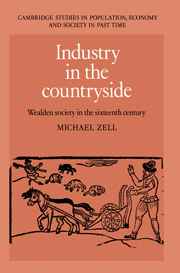Book contents
- Frontmatter
- Contents
- List of figures
- List of tables
- Acknowledgements
- List of abbreviation
- 1 Introduction
- 2 Landholding, inheritance and the local land market
- 3 Demographic movements, household structure and geographical mobility
- 4 The Wealden agrarian regime
- 5 Occupational structure and levels of wealth in the Weald
- 6 The textile industry in the Weald
- 7 Clothiers and capitalism
- 8 The Weald and ‘proto-industrialization’
- Bibliography
- Index
- Cambridge Studies in Population, Economy and Society in Past Time
6 - The textile industry in the Weald
Published online by Cambridge University Press: 13 October 2009
- Frontmatter
- Contents
- List of figures
- List of tables
- Acknowledgements
- List of abbreviation
- 1 Introduction
- 2 Landholding, inheritance and the local land market
- 3 Demographic movements, household structure and geographical mobility
- 4 The Wealden agrarian regime
- 5 Occupational structure and levels of wealth in the Weald
- 6 The textile industry in the Weald
- 7 Clothiers and capitalism
- 8 The Weald and ‘proto-industrialization’
- Bibliography
- Index
- Cambridge Studies in Population, Economy and Society in Past Time
Summary
The manufacture of woollen textiles was a flourishing industry in the Kentish Weald long before the sixteenth century. Local tradition has it that one of Edward III's imported Flemish weavers set up shop in Cranbrook in the 1330s, thus founding the Wealden broadcloth industry. The story is probably apocryphal. By the middle of the fifteenth century, however, clothmaking in the central Wealden district was well established and was probably responsible for the bulk of cloth production within the county, although clothmaking was still a significant industry in Canterbury. The second half of the fifteenth century ushered in a period of sustained expansion in Wealden clothmaking, in line with the growth of textile production in England as a whole. The somewhat sketchy accounts made in the 1470s by the farmers of the tax on woollen textiles, the ulnage, show that the residences of men who paid were predominantly in the Weald. The number of cloths ‘produced’ and taxed had by this time become conventionalized, fictional totals. By Henry VIII's reign the scale of Wealden woollen production – although not precisely quantifiable – was large and growing. The subsidy rolls of the 1520s imply that the industry was already dominated by the larger clothiers: the tax assessments of the major Cranbrook clothiers placed them on a level with the local gentry. The social and economic structure of the industry was by this time established in the pattern which would continue for another century before its long, slow demise in the seventeenth century.
- Type
- Chapter
- Information
- Industry in the CountrysideWealden Society in the Sixteenth Century, pp. 153 - 188Publisher: Cambridge University PressPrint publication year: 1994

